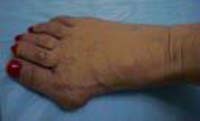Hallux Valgus (Bunions)
Indications
A bunion or hallux valgus, is an angular deformity of the metatarso-phalangeal joint of the great toe. It can lead to pain and difficulty with shoe wear. If left alone, it may progress leading to secondary changes such as over/under-riding of the great toe over the second toe. Other secondary changes include a rotatory deformity of the great toe leading to callosities or hardened skin on the inner aspect of the great toe and a hammer toe deformity of the second toe as it is pushed out of the way by the deforming force of the great toe. It is preferable to treat the bunion, or Hallux Valgus before such secondary changes appear, as the surgical treatment is less complex. When secondary changes have occurred, these may also need to be dealt with especially if they have progressed and become fixed deformities. A fixed deformity is one that cannot be corrected by manipulation as it has become rigid and the only way that correction of a fixed deformity can be achieved is by surgical intervention.
Indication for Surgical Treatment
Pain and difficulty with shoe wear and the presence of secondary changes would be the indications for surgery.
A Hallux Valgus Deformity
Operation
The correction of a Hallux Valgus is carried out under either a regional or a general anaesthetic either as a day case procedure or an overnight stay. Through an incision over the great toe and first metatarsal, the metatarso-phalangeal joint is exposed. The first metatarsal is osteotomised (broken) and the deformity corrected. The osteotomy is fixed using small screws so that the corrected fragment of bone is securely fixed. In order to support this fixation, a small bootee is applied to the foot and worn for three weeks, by which time this cast can be removed and physiotherapy if required can be commenced.
Risks and Complications
The most common complication is one of swelling following surgery. This is due to the fact that the foot is the most dependant part of the body and any surgery will lead to some swelling. This normally resolves with time, but may require physiotherapy to speed up resolution. As with any surgery, infection can occur, although in our experience this is unlikely. Very occasionally displacement of the Osteotomy can occur, but this again is extremely unlikely. Recurrence of the deformity can rarely occur but this, if it does occur appears many years after surgery.
